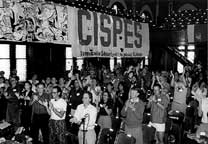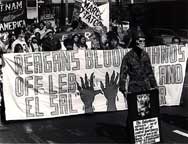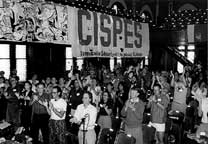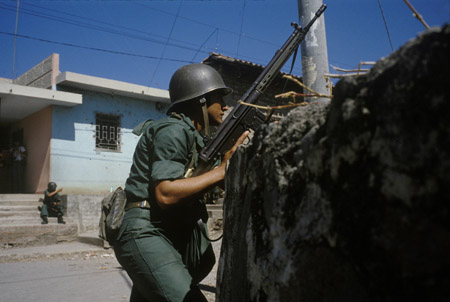 In 1985 CISPES held it’s first official national convention, with chapters throughout the country sending representatives to participate in debate on the future strategy and program of the organization. Hundreds attended and a slate lead by Angela Sanbrano won the elections for leadership of the organization. Angela became CISPES’s first executive director.
In 1985 CISPES held it’s first official national convention, with chapters throughout the country sending representatives to participate in debate on the future strategy and program of the organization. Hundreds attended and a slate lead by Angela Sanbrano won the elections for leadership of the organization. Angela became CISPES’s first executive director.
Category: Early years (1981 – 1985)
National Referendum to End the War
The National Referendum to End the War was a campaign to call for the US government to end military aid to Central America. It involved canvassing and tabling in an effort to get people of the U.S. to sign on. 500,000 ballots were delivered to the Congress by prominent figures like Jesse Jackson, Ann Lewis, Father Luis Olivares.
FBI spying on CISPES
 As early as 1981 the FBI had begun to spy on CISPES, and later Freedom of Information Act (FOIA) requests revealed that it had become a major surveillance operation by 1985, spinning off into 178 separate investigations involving all 59 FBI field offices probing 1,330 organizations.
As early as 1981 the FBI had begun to spy on CISPES, and later Freedom of Information Act (FOIA) requests revealed that it had become a major surveillance operation by 1985, spinning off into 178 separate investigations involving all 59 FBI field offices probing 1,330 organizations.
The large domestic spying operation had the goal of “breaking†CISPES. Agents infiltrated committee meetings, spied on demonstrations, and harassed people at their fulltime, non-CISPES, jobs. Break-ins and thefts targeted offices and the cars and homes of activists. The names of more than 100,000 activists ended up in the Bureau’s ‘terrorist databank’. Paid spy Frank Varelli infiltrated Dallas CISPES, under instructions to de-legitimize CISPES by seducing the nuns who were lead organizers in the committee.
read an extended article here
Debate over Rainbow Coalition
 Starting in 1983, a heated debate developed within CISPES over the role of national multi-issue coalition building. One faction wanted to keep the focus on Central America and make a big, national, grassroots push against further intervention in El Salvador. The other faction believed CISPES should prioritize helping to build the newly formed Rainbow Coalition, which was organizing around the candidacy of Jessie Jackson in the Democratic presidential primaries. This group argued that in order for CISPES to be part of building a broad progressive movement in the U.S., the organization had to work in coalition on domestic issues, especially racial justice. The former group recognized that it was a key moment for the revolution in El Salvador and therefore believed that expanding CISPES’s scope in such a way could weaken it’s anti-intervention work.
Starting in 1983, a heated debate developed within CISPES over the role of national multi-issue coalition building. One faction wanted to keep the focus on Central America and make a big, national, grassroots push against further intervention in El Salvador. The other faction believed CISPES should prioritize helping to build the newly formed Rainbow Coalition, which was organizing around the candidacy of Jessie Jackson in the Democratic presidential primaries. This group argued that in order for CISPES to be part of building a broad progressive movement in the U.S., the organization had to work in coalition on domestic issues, especially racial justice. The former group recognized that it was a key moment for the revolution in El Salvador and therefore believed that expanding CISPES’s scope in such a way could weaken it’s anti-intervention work.
The Sanctuary Movement
 As the war in El Salvador heated up, CISPES became active in a movement to provide safe-haven for Central American refugees fleeing civil conflict. The Sanctuary Movement was a religious and political campaign that began in the early 1980s which responded to restrictive federal immigration policies that made obtaining asylum difficult for Central Americans. At its peak, Sanctuary involved over 500 congregations across the country that, by declaring themselves official “sanctuaries,†committed to providing shelter, material goods and often legal advice to Central American refugees
As the war in El Salvador heated up, CISPES became active in a movement to provide safe-haven for Central American refugees fleeing civil conflict. The Sanctuary Movement was a religious and political campaign that began in the early 1980s which responded to restrictive federal immigration policies that made obtaining asylum difficult for Central Americans. At its peak, Sanctuary involved over 500 congregations across the country that, by declaring themselves official “sanctuaries,†committed to providing shelter, material goods and often legal advice to Central American refugees
Pledge of Resistance
 During a gathering of peace and justice activists at the Kirkridge Retreat Center in Pennsylvania in November 1983, Sojourners magazine drafted a “Promise of Resistance” that was revised and signed by 33 activists, vowing that if the US invaded Nicaragua, they would go there unarmed as a loving barrier. They sent copies of the statement to members of Congress, President Reagan, the Defense Department, and the CIA. In the August 1984 issue of Sojourners the idea was altered to occupy congressional offices and was called a “Pledge of Resistance.”
During a gathering of peace and justice activists at the Kirkridge Retreat Center in Pennsylvania in November 1983, Sojourners magazine drafted a “Promise of Resistance” that was revised and signed by 33 activists, vowing that if the US invaded Nicaragua, they would go there unarmed as a loving barrier. They sent copies of the statement to members of Congress, President Reagan, the Defense Department, and the CIA. In the August 1984 issue of Sojourners the idea was altered to occupy congressional offices and was called a “Pledge of Resistance.”
In Berkeley, CA, a document called “A Commitment to Stop the Killing in Central America” began to circulate. The Sojourners pledge was revised slightly and the local chapter of CISPES began gathering signatures for it. On October 9, 1984 outside the Federal Building in San Francisco seven hundred people signed the pledge in the first hour as two hundred people spoke why they were willing to risk going to jail. CISPES remained involved with “The Pledge” throughout the 80s.
Reagan draws a line in the sand
 In 1981, Ronald Reagan rode into office determined to overcome the Vietnam Syndrome and stop the tide of revolution in Central America. Reagan announced he “was drawing a line” in El Salvador, sending military advisors to aid the counterrevolution.
In 1981, Ronald Reagan rode into office determined to overcome the Vietnam Syndrome and stop the tide of revolution in Central America. Reagan announced he “was drawing a line” in El Salvador, sending military advisors to aid the counterrevolution.
El Salvador eventually became the site of the largest U.S.-backed counterinsurgency war since Vietnam. Recognizing the very real danger represented by the slogan “El Salvador is Spanish for Vietnam,” progressive activists flocked to the issue.
The First Final Offensive
 In January 1981, the FMLN launched a “final offensive,†just before Ronald Reagan assumed office. This attempt failed due to lack of arms and trained troops, and the guerrillas turned to consolidating their control over parts of the countryside. The final offensive was not a total loss for the FMLN, however. It retained military strongholds and settled in for a protracted guerrilla conflict. The offensive focused further international attention on El Salvador and established the FMLN/FDR as a formidable force both politically and militarily; in August 1981, the governments of France and Mexico recognized the front as a “representative political force” and called for a negotiated settlement between the rebels and the government. CISPES used the media attention of the final offensive to keep building the organization, now with hundreds of chapters and affiliates around the country.
In January 1981, the FMLN launched a “final offensive,†just before Ronald Reagan assumed office. This attempt failed due to lack of arms and trained troops, and the guerrillas turned to consolidating their control over parts of the countryside. The final offensive was not a total loss for the FMLN, however. It retained military strongholds and settled in for a protracted guerrilla conflict. The offensive focused further international attention on El Salvador and established the FMLN/FDR as a formidable force both politically and militarily; in August 1981, the governments of France and Mexico recognized the front as a “representative political force” and called for a negotiated settlement between the rebels and the government. CISPES used the media attention of the final offensive to keep building the organization, now with hundreds of chapters and affiliates around the country.
Churchwomen Kidnapped and Murdered by US-Trained Salvadoran Death Squad
 On December 2, 1980, Dorothy Kazel, Jean Donovan, Ita Ford, and Maura Clarke were intercepted on their way home from the airport in El Salvador. Five Salvadoran National Guardsmen kidnapped, raped, and killed them. Their murders and the subsequent outcry by CISPES and other solidarity organizations was a factor in catalyzing a broad Central America anti-intervention movement in the US.
On December 2, 1980, Dorothy Kazel, Jean Donovan, Ita Ford, and Maura Clarke were intercepted on their way home from the airport in El Salvador. Five Salvadoran National Guardsmen kidnapped, raped, and killed them. Their murders and the subsequent outcry by CISPES and other solidarity organizations was a factor in catalyzing a broad Central America anti-intervention movement in the US.
The families of the women killed filed a lawsuit in May, 1999, naming Carlos Eugenio Vides Casanova and José Guillermo GarcÃa responsible for the murders. On November 3, 2000, a jury in West Palm Beach, Fla., found the two Salvadoran generals not guilty under the 1991 federal Torture Victims Protection Act. GarcÃa was Minister of Defense and Vides was head of the National Guard of El Salvador at the time of the crimes.
The four American women were among 75,000 to lose their lives in El Salvador during the country’s 12-year civil war, which ended in 1992. Ford and Clarke were nuns from the Maryknoll Order in Maryknoll, N.Y. Kazel was a nun in the Ursuline Order. Donovan was an accountant before going to El Salvador.



